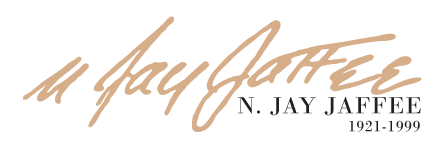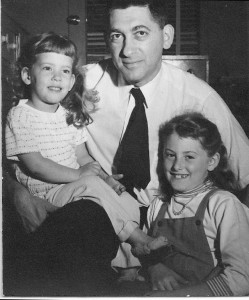N. Jay Jaffee, born in Brooklyn in 1921, was a photographer of distinctive black-and-white photographs, revealing a sensitive and probing social intelligence. He saw and recorded human activity: a lonely, windswept boardwalk; a whimsical sculpture; men sunning themselves amidst the city grime; the crisp balance of lines and light in a sparkling cityscape; a teddy bear on a clothesline. His photographs not only record the instant, they communicate the substance. The images are exquisite, enduring expositions of lights and shadow, visual textures in balanced tension. They are also filled with wit and humor, and a profound understanding of the ironies in all of our lives.
—Janie Welker, Curator, Heckscher Museum
Jay Jaffee’s work lets his viewers hold time in their hearts. The photographs do this not only as documents of their era or records of specific places and events, but as conveyers of the unmistakable feeling surrounding and evoked by their specific details and serendipitously-observed harmonies, a quality photographer Berenice Abbott called a “tenderness” for the subject, expressed through the photographer’s intellectual and emotional perception. Jay’s photographs are a sensibility on display that invites us to look and understand as he did.
—Julia Van Haaften, Curator of Photography, New York Public Library
Read the whole article: In Memoriam
Born Nathan Jaffee to Isidore and Anna Jaffee, N. Jay Jaffee was raised in various Brooklyn neighborhoods, from Brownsville to East New York to Brighton Beach. After a difficult childhood, and the death of his mother when he was 15, he left school to work as a typesetter. In 1947, fresh out of the army, recently married, and struggling to reconcile his experiences of war with the society to which he returned, Jaffee picked up his camera. He had been an infantry squad leader during World War II and had seen heavy combat in Europe. Initially photographing was a catharsis, a means of affirming life in contrast to the irrational destruction of war. By rejoicing in and recording the humor and warmth of the social community—people in pursuit of their daily lives—he was able to transform the fear and horror that had remained as a legacy of war.
Jaffee started photographing the Brooklyn neighborhoods in which he grew up. Manhattan also beckoned, as did Queens, and eventually Long Island. His work captured the movements and shadows of the city streets, subways, signs, markets, and the people who inhabited them. His formal training came after he had been photographing for some time. He attended classes taught by Sid Grossman, of the legendary Photo League, and met with Edward Steichen, then curator of photography at the Museum of Modern Art. Steichen offered encouragement and requested three prints, which became part of the museum’s permanent collection. In 1950, two were included in the group show “Fifty-One American Photographers.”
While raising a family—he had two daughters, Anna and Cyrisse, with his wife Isabel—and working in the printing industry, Jaffee continued to photograph in the classic black-and-white format. Jaffee eventually moved to Huntington, Long Island. Although he had always photographed nature, his later work included more landscapes and, through his travels, the sights and sounds of Europe.
A major one-person show, “Inward Image,” was exhibited at the Brooklyn Museum in 1981. Many exhibits followed, and his work was added to many major museums and institutions, including the Museum of Modern Art, the Metropolitan Museum of Art, the Smithsonian Institution, the National Portrait Gallery, the Library of Congress, the National Museum of American Art, the New York Public Library, the Brooklyn Public Library, the Bibliotheque nationale de France, the International Museum of Photography and Film (George Eastman House), the Museum of Fine Arts (Boston), and the Fogg Art Museum at Harvard University. After being represented by the Howard Greenberg Gallery in New York, he formed a close working relationship with the Sarah Morthland Gallery, also in New York. (For more information, see Exhibitions.)
A book of his photographs, N. Jay Jaffee: Photographs 1947–1956, was published in 1976. His work has also been included in: American Century of Photography: From Dry-Plate to Digital, edited by Keith David; Cityscapes: A History of New York in Images by Howard B. Rock and Deborah Dash Moore; This Was the Photo League: Compassion and the Camera from the Depression to the Cold War by Anne Wilkes Tucker, Claire Cass, and Stephen Daiter; and When Brooklyn Was the World by Elliott Willensky.
In September 1999, a 50-year retrospective, “Coney Island to Camusett: The Photographic Journey of N. Jay Jaffee: 1947–1999,” organized before his death in March of that year, was shown at the Heckscher Museum of Art in Huntington, New York. Just before his death, he established The N. Jay Jaffee Trust, which now holds his complete work and negatives.
For more than half a century, the camera served as an instrument through which Jaffee interpreted the world and his position in it. Much of his work can be seen as a form of self-portrait, a barometer of his sense of self at various times in his life. “Photographs,” he once wrote, “are born of the positives and negatives accumulated in a lifetime.”
This biography was adapted from the exhibition catalog Coney Island to Caumsett: The Photographic Journey of N. Jay Jaffee: 1947–1997, by Janie Welker, Heckscher Museum, 1999.


